SLVSCT3 March 2015 TPS51275B-1
PRODUCTION DATA.
- 1 Features
- 2 Applications
- 3 Description
- 4 Typical Application Diagram
- 5 Revision History
- 6 Pin Configuration and Functions
- 7 Specifications
-
8 Detailed Description
- 8.1 Overview
- 8.2 Functional Block Diagram
- 8.3
Feature Description
- 8.3.1 PWM Operations
- 8.3.2 Adaptive On-Time and PWM Frequency Control
- 8.3.3 Light-Load Condition in Out-of-Audio Operation
- 8.3.4 Enable and Power Good
- 8.3.5 Soft-Start and Discharge
- 8.3.6 VREG5 and VREG3 Linear Regulators
- 8.3.7 VCLK for Charge Pump
- 8.3.8 Overcurrent Protection
- 8.3.9 Output Overvoltage and Undervoltage Protection
- 8.3.10 Undervoltage Lockout Protection
- 8.3.11 Over-Temperature Protection (OTP)
- 8.4 Device Functional Modes
- 9 Application and Implementation
- 10Power Supply Recommendations
- 11Layout
- 12Device and Documentation Support
- 13Mechanical, Packaging, and Orderable Information
Package Options
Mechanical Data (Package|Pins)
- RUK|20
Thermal pad, mechanical data (Package|Pins)
- RUK|20
Orderable Information
7 Specifications
7.1 Absolute Maximum Ratings(1)
over operating free-air temperature range (unless otherwise noted)| MIN | MAX | UNIT | ||
|---|---|---|---|---|
| Input voltage(2) | VBST1, VBST2 | –0.3 | 32 | V |
| VBST1, VBST2(3) | –0.3 | 6 | ||
| SW1, SW2 | –6.0 | 26 | ||
| VIN | –0.3 | 26 | ||
| EN1, EN2 | –0.3 | 6 | ||
| VFB1, VFB2 | –0.3 | 3.6 | ||
| VO1 | –0.3 | 6 | ||
| Output voltage(2) | DRVH1, DRVH2 | –6.0 | 32 | V |
| DRVH1, DRVH2(3) | –0.3 | 6 | ||
| DRVH1, DRVH2(3) (pulse width < 20 ns) | –2.5 | 6 | ||
| DRVL1, DRVL2 | –0.3 | 6 | ||
| DRVL1, DRVL2 (pulse width < 20 ns) | –2.5 | 6 | ||
| PGOOD, VCLK, VREG5 | –0.3 | 6 | ||
| VREG3, CS1, CS2 | –0.3 | 3.6 | ||
| Junction temperature, TJ | 150 | °C | ||
| Storage temperature, Tstg | –55 | 150 | °C | |
(1) Stresses beyond those listed under absolute maximum ratings may cause permanent damage to the device. These are stress ratings only and functional operation of the device at these or any other conditions beyond those indicated under recommended operating conditions is not implied. Exposure to absolute-maximum-rated conditions for extended periods may affect device reliability.
(2) All voltage values are with respect to the network ground terminal unless otherwise noted
(3) Voltage values are with respect to SW terminals.
7.2 ESD Ratings
| VALUE | UNIT | |||
|---|---|---|---|---|
| V(ESD) | Electrostatic discharge | Human body model (HBM), per ANSI/ESDA/JEDEC JS-001, all pins(1) | ±2000 | V |
| Charged device model (CDM), per JEDEC specification JESD22-C101, all pins(2) | ±1000 | |||
(1) JEDEC document JEP155 states that 500-V HBM allows safe manufacturing with a standard ESD control process.
(2) JEDEC document JEP157 states that 250-V CDM allows safe manufacturing with a standard ESD control process.
7.3 Recommended Operating Conditions
over operating free-air temperature range (unless otherwise noted)| MIN | MAX | UNIT | ||
|---|---|---|---|---|
| Supply voltage | VIN | 5 | 24 | V |
| Input voltage(1) | VBST1, VBST2 | –0.1 | 30 | V |
| VBST1, VBST2(2) | –0.1 | 5.5 | ||
| SW1, SW2 | –5.5 | 24 | ||
| EN1, EN2 | –0.1 | 5.5 | ||
| VFB1, VFB2 | –0.1 | 3.5 | ||
| VO1 | –0.1 | 5.5 | ||
| Output voltage(1) | DRVH1, DRVH2 | –5.5 | 30 | V |
| DRVH1, DRVH2(2) | –0.1 | 5.5 | ||
| DRVL1, DRVL2 | –0.1 | 5.5 | ||
| PGOOD, VCLK, VREG5 | –0.1 | 5.5 | ||
| VREG3, CS1, CS2 | –0.1 | 3.5 | ||
| Operating free-air temperature, TA | –40 | 85 | °C | |
(1) All voltage values are with respect to the network ground terminal unless otherwise noted.
(2) Voltage values are with respect to the SW terminal.
7.4 Thermal Information
| THERMAL METRIC(1) | RUK (WQFN) | UNIT | |
|---|---|---|---|
| 20 PINS | |||
| RθJA | Junction-to-ambient thermal resistance | 94.1 | °C/W |
| RθJC(top) | Junction-to-case (top) thermal resistance | 58.1 | |
| RθJB | Junction-to-board thermal resistance | 64.3 | |
| ψJT | Junction-to-top characterization parameter | 31.8 | |
| ψJB | Junction-to-board characterization parameter | 58.0 | |
| RθJC(bot) | Junction-to-case (bottom) thermal resistance | 5.9 | |
(1) For more information about traditional and new thermal metrics, see the IC Package Thermal Metrics application report, SPRA953.
7.5 Electrical Characteristics
over operating free-air temperature range, VVIN = 12 V, VVO1 = 5 V, VVFB1 = VVFB2 = 2 V, VEN1 = VEN2 = 3.3 V (unless otherwise noted)| PARAMETER | TEST CONDITIONS | MIN | TYP | MAX | UNIT | |||
|---|---|---|---|---|---|---|---|---|
| SUPPLY CURRENT | ||||||||
| IVIN1 | VIN supply current-1 | TA = 25°C, No load, VVO1 = 0 V | 860 | μA | ||||
| IVIN2 | VIN supply current-2 | TA = 25°C, No load | 30 | μA | ||||
| IVO1 | VO1 supply current | TA = 25°C, No load, VVFB1 = VVFB2 = 2.05 V | 900 | μA | ||||
| IVIN(STBY) | VIN stand-by current | TA = 25°C, No load, VVO1 = 0 V, VEN1= VEN2 = 0 V | 180 | μA | ||||
| INTERNAL REFERENCE | ||||||||
| VFBx | VFB regulation voltage | TA = 25°C | 1.99 | 2 | 2.01 | V | ||
| 1.98 | 2 | 2.02 | ||||||
| VREG5 OUTPUT | ||||||||
| VVREG5 | VREG5 output voltage | TA = 25°C, No load, VVO1 = 0 V | 4.9 | 5 | 5.1 | V | ||
| VVIN > 7 V , VVO1 = 0 V, IVREG5 < 100 mA | 4.85 | 5 | 5.1 | |||||
| VVIN > 5.5 V , VVO1 = 0 V, IVREG5 < 35 mA | 4.85 | 5 | 5.1 | |||||
| VVIN > 5 V, VVO1 = 0 V, IVREG5 < 20 mA | 4.50 | 4.75 | 5.1 | |||||
| IVREG5 | VREG5 current limit | VVO1 = 0 V, VVREG5 = 4.5 V, VVIN = 7 V | 100 | 150 | mA | |||
| RV5SW | 5-V switch resistance | TA = 25°C, VVO1 = 5 V, IVREG5 = 50 mA | 1.8 | Ω | ||||
| VREG3 OUTPUT | ||||||||
| VVREG3 | VREG3 output voltage | No load, VVO1= 0 V, TA = 25°C | 3.267 | 3.3 | 3.333 | V | ||
| VVIN > 7 V , VVO1= 0 V, IVREG3< 100 mA | 3.217 | 3.3 | 3.383 | |||||
| 5.5 V < VVIN , VVO1= 0 V, IVREG3< 35 mA | 3.234 | 3.3 | 3.366 | |||||
| 0°C ≤ TA ≤ 85°C, VVIN > 5.5 V, VVO1 = 0 V, IVREG3< 35 mA |
3.267 | 3.3 | 3.333 | |||||
| 0°C ≤ TA ≤ 85°C, VVIN > 5.5 V, VVO1 = 5 V, IVREG3 < 35 mA |
3.267 | 3.3 | 3.333 | |||||
| VVIN > 5 V, VVO1 = 0 V, IVREG3< 35 mA | 3.217 | 3.3 | 3.366 | |||||
| IVREG3 | VREG3 current limit | VVO1 = 0 V, VVREG3 = 3.0 V, VVIN= 7 V | 100 | 150 | mA | |||
| MOSFET DRIVERS | ||||||||
| RDRVH | DRVH resistance | Source, (VVBST – VDRVH) = 0.25 V, (VVBST – VSW) = 5 V | 3 | Ω | ||||
| Sink, (VDRVH – VSW) = 0.25 V, (VVBST – VSW) = 5 V | 1.9 | |||||||
| RDRVL | DRVL resistance | Source, (VVREG5 – VDRVL) = 0.25 V, VVREG5 = 5 V | 3 | Ω | ||||
| Sink, VDRVL = 0.25 V, VVREG5= 5 V | 0.9 | |||||||
| INTERNAL BOOT STRAP SWITCH | ||||||||
| RVBST (ON) | Boost switch on-resistance | TA = 25°C, IVBST = 10 mA | 13 | Ω | ||||
| IVBSTLK | VBST leakage current | TA = 25°C | 1 | µA | ||||
| CLOCK OUTPUT | ||||||||
| RVCLK (PU) | VCLK on-resistance (pullup) | TA = 25°C | 10 | Ω | ||||
| RVCLK (PD) | VCLK on-resistance (pulldown) | TA = 25°C | 10 | Ω | ||||
| OUTPUT DISCHARGE | ||||||||
| RDIS1 | CH1 discharge resistance | TA = 25°C, VVO1 = 0.5 V VEN1 = VEN2 = 0 V |
35 | Ω | ||||
| RDIS2 | CH2 discharge resistance | TA = 25°C, VSW2 = 0.5 V, VEN1 = VEN2 = 0 V | 70 | Ω | ||||
| POWER GOOD | ||||||||
| VPGTH | PG threshold | Lower (rising edge of PG-in) | 92.5% | 95.0% | 97.5% | |||
| Hysteresis | 5% | |||||||
| Upper (rising edge of PG-out) | 107.5% | 110.0% | 112.5% | |||||
| Hysteresis | 5% | |||||||
| IPGMAX | PG sink current | VPGOOD = 0.5 V | 6.5 | mA | ||||
| IPGLK | PG leakage current | VPGOOD = 5.5 V | 1 | µA | ||||
| CURRENT SENSING | ||||||||
| ICS | CS source current | TA = 25°C, VCS= 0.4 V | 9 | 10 | 11 | μA | ||
| TCCS | CS current temperature coefficient(1) | On the basis of 25°C | 4500 | ppm/°C | ||||
| VCS | CS current-limit setting range | 0.2 | 2 | V | ||||
| VZC | Zero cross detection offset | TA = 25°C | –1 | 1 | 3 | mV | ||
| LOGIC THRESHOLD | ||||||||
| VENX(ON) | EN threshold high-level | SMPS on level | 1.6 | V | ||||
| VENX(OFF) | EN threshold low-level | SMPS off level | 0.3 | V | ||||
| IEN | EN input current | VENx= 3.3 V | –1 | 1 | µA | |||
| OUTPUT OVERVOLTAGE PROTECTION | ||||||||
| VOVP | OVP trip threshold | 112.5% | 115.0% | 117.5% | ||||
| OUTPUT UNDERVOLTAGE PROTECTION | ||||||||
| VUVP | UVP trip threshold | 55% | 60% | 65% | ||||
| UVLO | ||||||||
| VUVL0VIN | VIN UVLO threshold | Wake up | 4.58 | V | ||||
| Hysteresis | 0.5 | |||||||
| VUVLO5 | VREG5 UVLO threshold | Wake up | 4.38 | 4.5 | V | |||
| Hysteresis | 0.4 | |||||||
| VUVLO3 | VREG3 UVLO threshold | Wake up | 3.15 | V | ||||
| Hysteresis | 0.15 | |||||||
| OVERTEMPERATURE PROTECTION | ||||||||
| TOTP | OTP threshold(1) | Shutdown temperature | 155 | °C | ||||
| Hysteresis | 10 | |||||||
(1) Ensured by design. Not production tested.
7.6 Timing Requirements
over operating free-air temperature range, VVIN = 12 V, VVO1 = 5 V, VVFB1 = VVFB2 = 2 V, VEN1 = VEN2 = 3.3 V (unless otherwise noted)| MIN | NOM | MAX | UNIT | |||
|---|---|---|---|---|---|---|
| DUTY CYCLE AND FREQUENCY CONTROL | ||||||
| fsw1 | CH1 frequency(1) | TA = 25°C, VVIN= 20 V | 240 | 300 | 360 | kHz |
| fSW2 | CH2 frequency(1) | TA = 25°C, VVIN= 20 V | 280 | 355 | 430 | kHz |
| tOFF(MIN) | Minimum off-time | TA = 25°C | 200 | 300 | 500 | ns |
| MOSFET DRIVERS | ||||||
| tD | Dead time | DRVH-off to DRVL-on | 12 | ns | ||
| DRVL-off to DRVH-on | 20 | |||||
7.7 Switching Characteristics
over operating free-air temperature range, VVIN = 12 V, VVO1 = 5 V, VVFB1 = VVFB2 = 2 V, VEN1 = VEN2 = 3.3 V (unless otherwise noted)| PARAMETER | TEST CONDITIONS | MIN | TYP | MAX | UNIT | |
|---|---|---|---|---|---|---|
| CLOCK OUTPUT | ||||||
| fCLK | Clock frequency | TA = 25°C | 260 | kHz | ||
| SOFT-START OPERATION | ||||||
| tSS | Soft-start time | From ENx = HI and VVREG5 > VUVLO5 to VOUT = 95% | 3.25 | ms | ||
| tSSRAMP | Soft-start time (ramp-up) | VOUT= 0% to VOUT = 95%, VVREG5 = 5 V | 3.12 | ms | ||
| POWER GOOD | ||||||
| tPGDEL | PG delay | From PG lower threshold (95% = typical) to PG flag high | 1.38 | ms | ||
| OUTPUT OVERVOLTAGE PROTECTION | ||||||
| tOVPDLY | OVP propagation delay | TA = 25°C | 0.5 | µs | ||
| OUTPUT UNDERVOLTAGE PROTECTION | ||||||
| tUVPDLY | UVP propagation delay | 250 | µs | |||
| tUVPENDLY | UVP enable delay | From ENx = HI and VVREG5 > VUVLO5 to UV latch off | 4.3 | ms | ||
7.8 Typical Characteristics
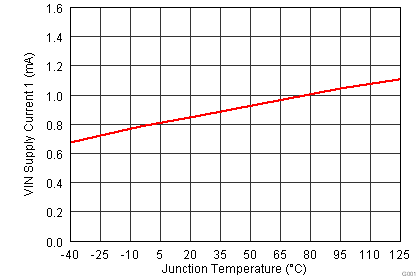
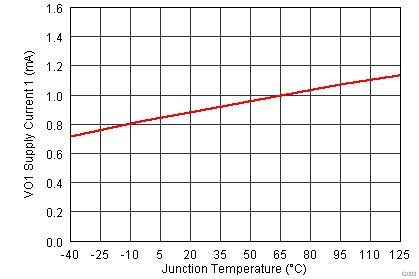
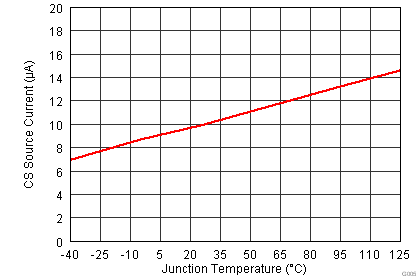
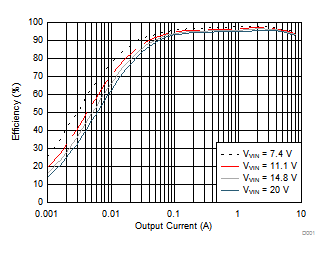
| Out-of-Audio mode | VVOUT1 = 5 V | |
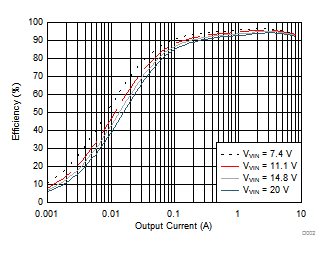
| Out-of-Audio mode | VVOUT2 = 3.3 V | |
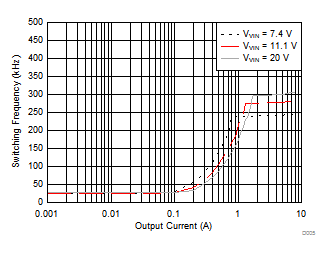
| Out-of-Audio mode | VVOUT1 = 5 V | |
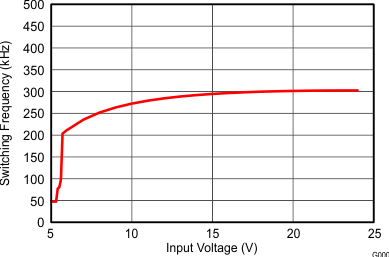
| VOUT1 = 5 V | IOUT1 = 6 A |
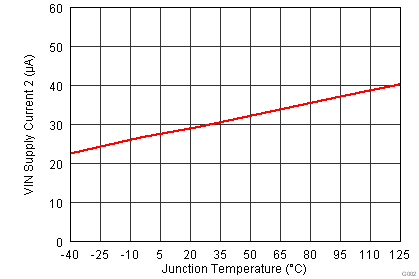
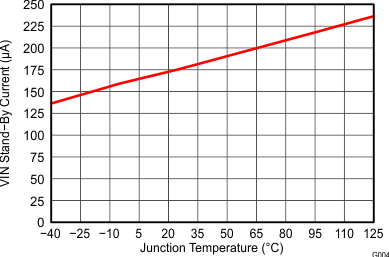
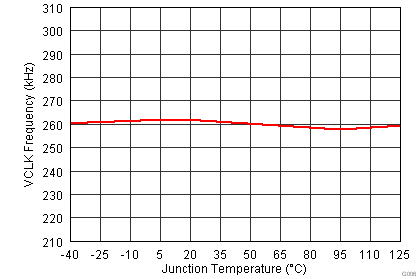
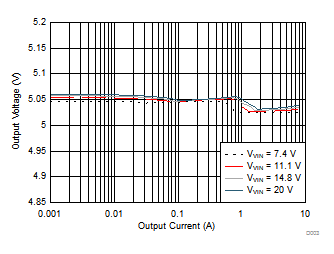
| Out-of-Audio mode | VVOUT1 = 5 V | |
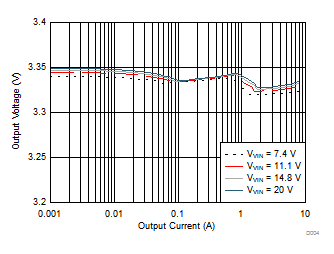
| Out-of-Audio mode | VVOUT2 = 3.3 V | |
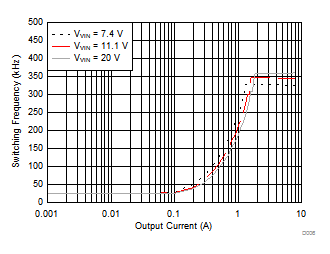
| Out-of-Audio mode | VVOUT2 = 3.3 V | |
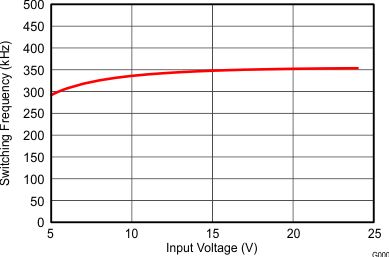
| VOUT2 = 3.3 V | IOUT2 = 6 A |